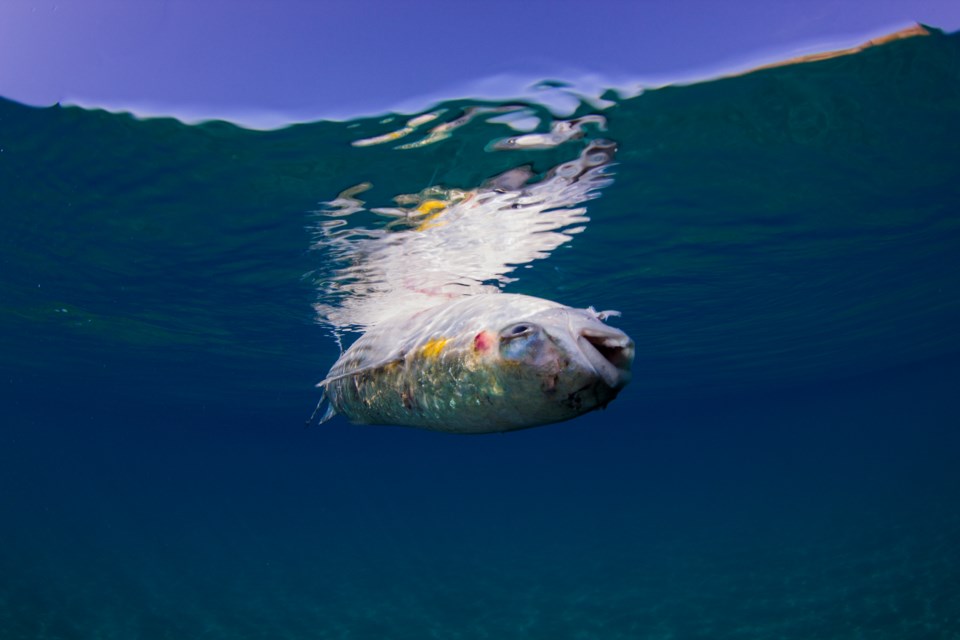A bacteria known to cause skin disease in fish was found to peak in juvenile Fraser River sockeye salmon in the Discovery Islands region, with one particularly big spike in 2015, a new study finds.
The study, involving scientists with the Strategic Salmon Health Initiative (SSHI) and published in Canadian Science Publishing, was based on modeling and samples taken from juvenile Fraser River sockeye between 2008 and 2018.
The SSHI is a collaboration between the Pacific Salmon Foundation, the Department of Fisheries and Oceans and GenomeBC.
The sampling was done when there were still roughly 30 open-net salmon farms in the Discovery Islands. They have since been removed, by order of the minister of Fisheries and Oceans Canada.
Of the 39 salmon pathogens detected, a bacteria called Tenacibaculum maritimum was the one “most strongly associated with active salmon farms.”
Unlike the strain of piscine orthoreovirus (PRV) found in B.C., which some studies suggest may be apathogenic (benign), Tenacibaculum maritimum is known to cause disease, and even mortality, in fish.
The study describes the bacterium as one that “does not invariably cause disease,” but which can cause a skin disease in fish called Tenacibaculosis, and in farmed Atlantic salmon can cause mouthrot.
The bacteria is one of nine pathogens associated with fish farms that DFO scientists reviewed and determined posed no more than a minimal risk to wild salmon.
“New evidence shows that one of the agents DFO assessed, Tenacibaculum maritimum, warrants further attention,” the study says.
About 90 per cent of Fraser River sockeye leaving fresh water for the ocean migrate up the inside of Vancouver Island, and are funneled through the Discovery Islands, which, until recently, hosted a number of open-net salmon farms.
The sampling showed “a clear peak in T. maritimum detections in the Discovery Islands region of British Columbia, where sockeye migrate close to salmon farms.
“The research estimates that exposure to Tenacibaculum peaks near farms in the Discovery Islands at more than 12 times the general background level,” the study finds.
“The vast majority of samples collected before and after the Discovery Islands, from the perspective of a migrating sockeye smolt, yielded no T. maritimum detections.”
In other words, the bacteria was not detected, or barely detected, in juvenile salmon once they were past the Discovery Islands – only in the immediate vicinity of the islands and fish farms.
“What looks like is happening…as they swam by, they picked up Tenacibaculum maritimum, and then they either recovered from that exposure or suffered mortality,” Andrew Bateman, a population ecologist at the Pacific Salmon Foundation and lead author of the study, told BIV News.
The high levels of bacteria detected in juvenile sockeye in the region over the 10-year survey period was skewed by exceptionally high levels in 2015.
“There was substantial interannual variation in the prevalence of T. maritimum detections, with almost three quarters of detections seen in a single year, 2015.”
This corresponded with a year of “anomalously high ocean temperatures.”
“This further corresponded to particularly poor marine survival for the Fraser sockeye that migrated to sea that year and returned to spawn in 2017.”
Ultimately, the study concludes that, “Fraser River sockeye infected with or exposed to T. maritimum are most prevalent near salmon farms in the Discovery Islands, implying that those farms are—at a minimum—likely sources of exposure.”
Now that the Discovery Islands are free of fish farms, it presents scientists with an ideal follow-up control experiment.
Asked if the SSHI plans to continue its sampling and modeling of juvenile Fraser River sockeye in and around the Discovery Islands to see if levels of T. maritimum now begin to fall, now that fish farms have been removed, Bateman said that is a possibility.
“We are certainly interested in continuing to monitor Fraser River sockeye,” Bateman said. “We have nothing lined up right at the moment, but it is very much on our radar.
“It’s a perfect scientific scenario and has relevance for Fraser River sockeye, obviously, so we will be making efforts to continue that kind of monitoring work in the years to come.”



